Celaeno, 16 Tauri (16 Tau), is a blue-white star located in the constellation Taurus. It is one of the nine brightest stars in the Pleiades cluster, one of the brightest and nearest open clusters to Earth. Celaeno lies at a distance of 430 light years from Earth has an apparent magnitude of 5.448.
Star type
Celaeno has the stellar classification B7 IV, indicating a subgiant star appearing blue-white in colour. Even though it shows the spectrum of a subgiant, its other properties suggest that it may still be in the late stages of the main sequence. The star has a mass four times that of the Sun and has expanded to a size of 4.4 solar radii. With an effective temperature of 12,800 K, it shines with 344 solar luminosities.
Like most other named Pleiades (all except Maia), Celaeno is a very fast spinner. It has a projected equatorial rotational velocity of 185 km/s.
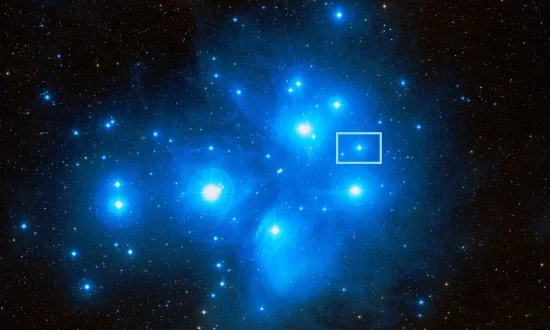
Celaeno (16 Tauri), image: Wikisky
Pleiades
The Pleiades cluster consists of more than 1,000 confirmed members and many other fainter and unresolved stars. The cluster’s tidal radius is about 43 light years, but its core radius is only 8 light years across. The brightest members are young, hot B-type stars formed in the last 100 million years.
The Pleiades stars lie at an average distance of 444 light years from the Sun. They were formed in the same region of space at about the same time and share a common proper motion. They will continue to move together through space for another 250 million years. The cluster will eventually disperse due to gravitational interactions with interstellar space.
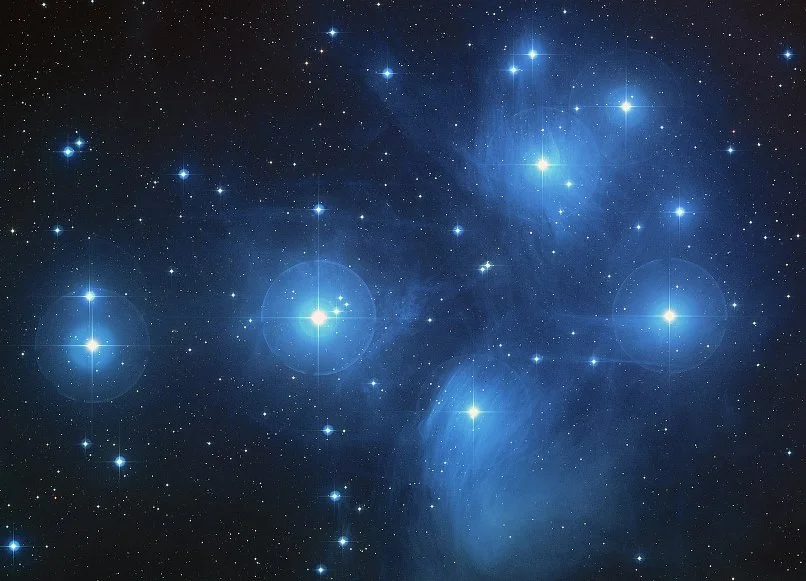
The Pleiades (M45), image: NASA, ESA, AURA/Caltech, Palomar Observatory, credit: D. Soderblom and E. Nelan (STScI), F. Benedict and B. Arthur (U. Texas), and B. Jones (Lick Obs.)
The cluster is one of the several well-known deep sky objects included in French astronomer Charles Messier’s catalogue. Messier famously catalogued 110 bright objects that may be confused for comets, and his inclusion of the Pleiades was curious because the cluster has been known to stargazers since ancient times. It was catalogued as the 45th entry in Messier’s catalogue and is commonly known as Messier 45 (M45).
The nine brightest stars in M45 are named after the Pleiades, the Seven Sisters in Greek mythology – Alcyone (Eta Tauri), Asterope (21 Tauri), Celaeno (16 Tauri), Electra (17 Tauri), Maia (20 Tauri), Merope (23 Tauri) and Taygeta (19 Tauri) – and their parents Atlas (27 Tauri) and Pleione (28 Tauri).
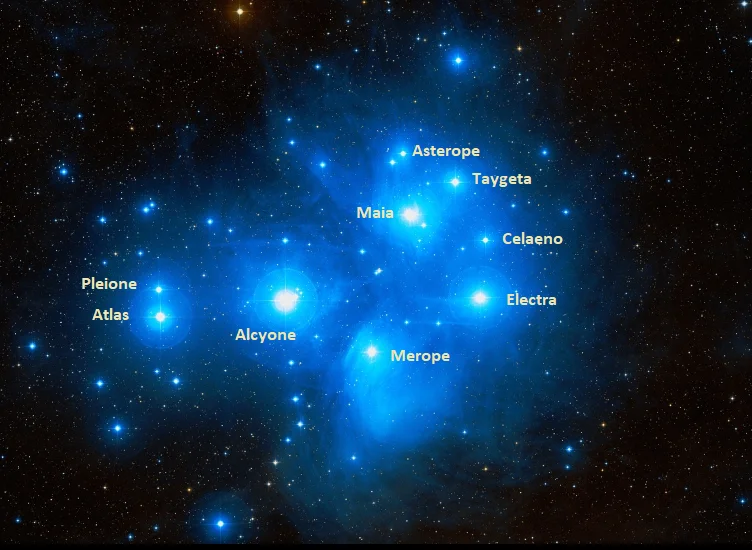
The Pleiades, image: Wikisky
In mythology, the sisters caught the eye of Orion, a giant huntsman. After their father Atlas was forced to uphold the heavens on his shoulders, Orion began to pursue the sisters. Zeus put an end to this, first transforming the sisters into doves and later into stars to comfort their father. It is said that the constellation Orion still keeps pursuing the Pleiades across the sky.
Facts
Celaeno was called “the Lost Pleiad” by the Greek scholar Theon of Alexandria (c. 335 CE – c. 405 CE). Other sources gave the title to Merope or Electra, even though both these stars are brighter and appear less “lost” than Celaeno. Celaeno itself would appear slightly brighter to us if it were not for 0.05 magnitudes of interstellar extinction.
The Pleiades cluster has been known to cultures across the globe since ancient times. The earliest record of the cluster was a depiction on the Nebra sky disk, a Bronze Age artifact discovered in Germany dating back to 1600 BCE. The cluster was also mentioned in a number of ancient texts, including the Bible, Homer’s Iliad and Odyssey, and Hesiod’s Works and Days.
Italian astronomer Galileo Galileo was the first to observe the Pleiades in a telescope. He discovered that the grouping contained a great number of fainter stars that were not visible to the unaided eye. Galilei published his notes and a sketch of the cluster in March 1610.
In Japan, the cluster is known as Subaru. The car company of the same name uses an image of the six brightest stars in its logo. In the 8th century, the cluster was known as Mutsuraboshi and mentioned in Kojiki (“An Account of Ancient Matters”), an early record of Japanese myths and legends.
Name
The name Celaeno (pronunciation: /sɪˈliːnoʊ/) comes from Greek mythology. Celaeno was one of the Pleiades, the seven daughters of the sea nymph Pleione and the Titan Atlas. The name itself is derived from the ancient Greek Κελαινώ (Kelaino), meaning “the dark one.” In mythology, Celaeno had four children by the god Poseidon and two by Prometheus.
The name was officially approved by the International Astronomical Union’s (IAU) Working Group on Star Names (WGSN) on August 21, 2016.
Location
Celaeno is easy to find because it is part of one of the most prominent features of the night sky. The Pleiades cluster lies along an imaginary line drawn from the stars of Orion’s Belt – Alnitak, Alnilam and Mintaka – past Aldebaran, the brightest star in Taurus. The cluster is located about 14 degrees northwest of the star. It is easy to find even without the Belt stars because it appears as a bright bunch of grapes in the sky.
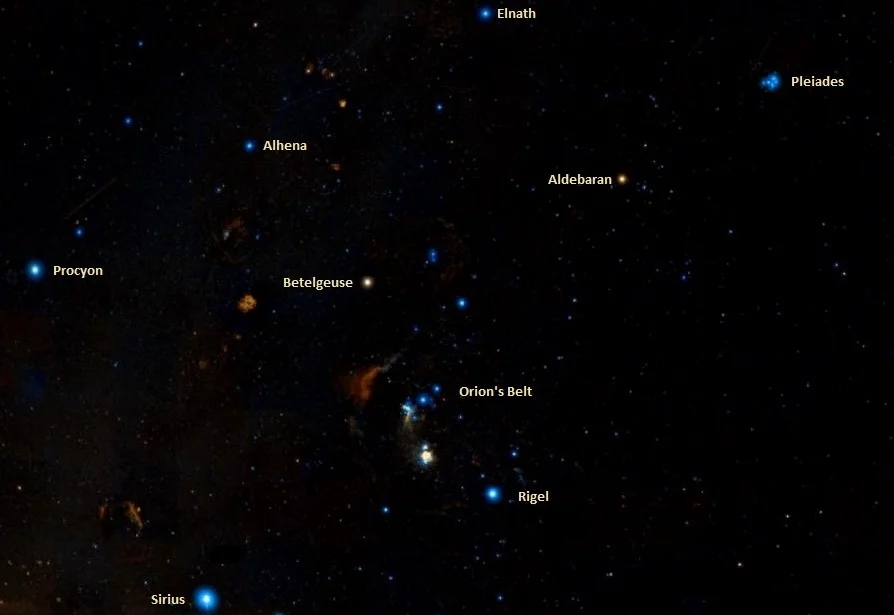
Pleiades location, image: Wikisky
The Pleiades can be seen in the evening sky from October to April. The cluster is invisible in May and June, when it is too close to the Sun.
Constellation
Celaeno is located in the constellation Taurus. Representing the Bull, Taurus is one of the largest northern constellations, stretching across an area of 797 square degrees. It is best known for containing Aldebaran, the 14th brightest star in the sky, and two exceptionally bright and large open clusters, the Pleiades and the Hyades. The V-shapes Hyades cluster outlines the head of the celestial Bull and the bright Aldebaran, appearing as the cluster’s brightest member (even though it is not), marks the Bull’s eye.
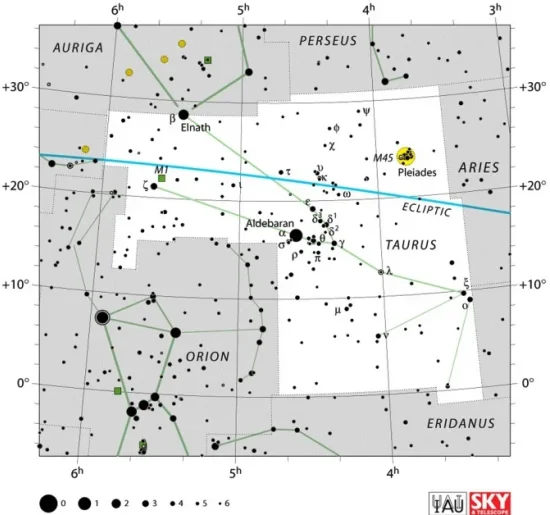
Taurus constellation map by IAU and Sky&Telescope magazine
Taurus also contains the Crab Nebula (Messier 1), a bright remnant of a historic supernova, Hind’s Variable Nebula (NGC 1555), a reflection nebula that changes in brightness due to being illuminated by the variable star T Tauri, and the planetary nebula NGC 1514, also known as the Crystal Ball Nebula.
The best time of year to observe the stars and deep sky objects in the constellation is during the month of January.
The 10 brightest stars in Taurus are Aldebaran (Alpha Tau, mag. 0.86), Elnath (Beta Tau, mag. 1.65), Alcyone (Eta Tau, mag. 2.87), Tianguan (Zeta Tau, mag. 2.97), Chamukuy (Theta2 Tauri, mag. 3.40), Lambda Tauri (mag. 3.47), Ain (Epsilon Tau, mag. 3.53), Omicron Tauri (mag. 3.61), Atlas (27 Tau, mag. 3.63), and Prima Hyadum (Gamma Tau, mag. 3.654).
Celaeno – 16 Tauri
| Spectral class | B7IV |
| U-B colour index | –0.33 |
| B-V colour index | –0.046 |
| Apparent magnitude | 5.448 |
| Absolute magnitude | -0.76 |
| Distance | 430 light years (130 parsecs) |
| Parallax | 7.53 ± 1.23 mas |
| Radial velocity | +2.9 km/s |
| Proper motion | RA: 20.73 mas/yr |
| Dec.: –44.00 mas/yr | |
| Mass | 4.0 M☉ |
| Luminosity | 344 L☉ |
| Radius | 4.4 R☉ |
| Temperature | 12,800 K |
| Rotational velocity | 185 km/s |
| Surface gravity | 3.9 cgs |
| Constellation | Taurus |
| Right ascension | 03h 44m 48.2154s |
| Declination | +24° 17′ 22.093″ |
| Designations | Celaeno, 16 Tauri, 16 Tau, HD 23288, HR 1140, HIP 17489, GC 4475, GCRV 2077, SAO 76126, BD+23 505, IRAS 03417+2407, PPM 92803, 2MASS J03444821+2417222, AAVSO 0338+23, TYC 1799-1440-1, Gaia DR2 65287458566524928 |